I Flunked JPN 101 in College. Twice.
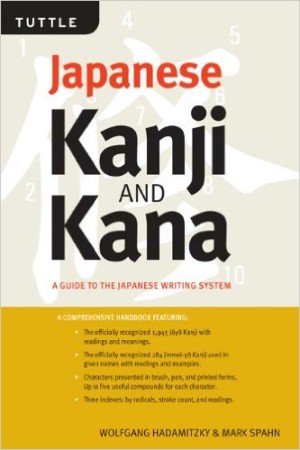 I studied Japanese formally for about eight years, but it was really eight years of the same three years’ worth of material, so while I know the elementary-level stuff really well, my comprehension is nowhere near where eight years should have brought me. It has always been my intention to continue my study independently, but you know how that goes. That kind of learning requires discipline, time, and some kind of structure, and Amazon Prime went on sale today and have you seen what they have streaming?
I studied Japanese formally for about eight years, but it was really eight years of the same three years’ worth of material, so while I know the elementary-level stuff really well, my comprehension is nowhere near where eight years should have brought me. It has always been my intention to continue my study independently, but you know how that goes. That kind of learning requires discipline, time, and some kind of structure, and Amazon Prime went on sale today and have you seen what they have streaming?
Still, I persist in short bursts of intense enthusiasm, usually spurred by some curious encounter with the language. My mother is from Japan, and she has helped me on occasion (my high-school Japanese teacher is a friend of hers, and I have been told many times that all my inflections and mannerisms are those of an old Japanese woman), but she’s not a patient teacher for the way I like to learn language, so I am left to my own devices until I can afford to purchase and neglect Rosetta Stone and its ilk.
But I’m Still Trying to Learn the Language.
I picked up Japanese Kanji and Kana (third edition, Tuttle Publishing 2012) hoping it would be a convenient reference for next to the computer. If a friend posts a selfie from Tokyo with interesting signage in the background, will I be able to flip through the book and get a general sense of whether she’s in the redlight district or electronic alley? When a former romantic interest (still friends, of course, because I’m that guy) texts me in all Japanese because when we started hanging out I may have led her to believe I know more of the language than I do, can I grab the book for a few minutes and fake a response? And most importantly, will doing so lead me to look up something else and learn another something new?
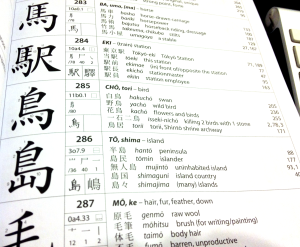 The book is designed to be used mostly as a reference, but the explanatory material in the first section of the book is excellent for the beginner and for whatever you’d call me. While my understanding of kana (the simpler, phonetic alphabet) is pretty solid, I learned a thing or two about some of the more confusing katakana (used for words introduced from other languages) conventions. The historic material, which many students skip, is meaty enough to satisfy geeky questions but not so demanding that I felt at all guilty about skimming through the more challenging sections.
The book is designed to be used mostly as a reference, but the explanatory material in the first section of the book is excellent for the beginner and for whatever you’d call me. While my understanding of kana (the simpler, phonetic alphabet) is pretty solid, I learned a thing or two about some of the more confusing katakana (used for words introduced from other languages) conventions. The historic material, which many students skip, is meaty enough to satisfy geeky questions but not so demanding that I felt at all guilty about skimming through the more challenging sections.
The crucial stuff explains how kanji (that complicated, pictographic language one normally associates with the Chinese and Japanese written languages) is categorized and indexed, a real challenge considering that each written symbol has multiple pronunciations and meanings, so simple alphabetical arrangements are close to impossible. With 2,136 distinct characters in common use, some kind of order is necessary, and the book does its best to explain the different methods. The indices in the back of the book employ some of these methods in referring to the heart of the content: individual entries for each kanji character.
The independent learner could begin with the first entry, do some writing practice, learn a few uses, and move to the next. Each entry provides the basic meanings and pronunciations, along with compounds (kanji characters combined for specific uses). It’s really helpful that the compounds provided only use kanji that appear before the entry you’re looking at, so if you’re progressing through the book in order, you’ll only see kanji you’re familiar with in the compounds. I know this sounds a little confusing, so in order to illustrate, I put the book to a test as a reference the way I am mostly likely to use it.
A Quick Test-Drive.
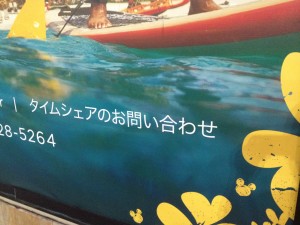 This is part of an enormous advertisement in Honolulu’s Ala Moana Center, for a Disney timeshare on the west side of Oahu. Most of the line is written in kana, so I could tell that it wasn’t a direct translation of the English that precedes it (cut off in this photo). The タイムシェア part is katakana, and it says “timeshare.” The お問い合わせ is the trouble spot for me: it’s a mix of hiragana (the phonetic alphabet for specifically Japanese words) and kanji. There are two kanji characters here: the 問 and 合.
This is part of an enormous advertisement in Honolulu’s Ala Moana Center, for a Disney timeshare on the west side of Oahu. Most of the line is written in kana, so I could tell that it wasn’t a direct translation of the English that precedes it (cut off in this photo). The タイムシェア part is katakana, and it says “timeshare.” The お問い合わせ is the trouble spot for me: it’s a mix of hiragana (the phonetic alphabet for specifically Japanese words) and kanji. There are two kanji characters here: the 問 and 合.
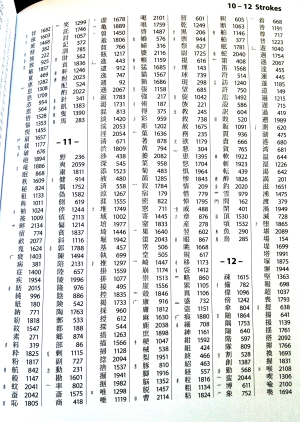 One of the book’s methods for indexing kanji is by the number of strokes used to write the character. Because I read the guide to strokes and stroke order in the first part of the book, I know that 問 contains eleven strokes, so I can find the kanji in the stroke order index in the section for eleven strokes. That looks like a lot, but when you’re used to way kanji looks, it stops looking like the last few ramen noodles in the bottom of the bowl and it starts to look like meaningful language, and skimming through the list isn’t that difficult. I promise: this looks intimidating if you have very little experience with the written language, but it honestly doesn’t take much practice before looking at this list isn’t at all daunting. I don’t know what any of the kanji on this page mean, but scanning this eleven strokes section (it’s only five columns, right?) only takes a few seconds. And look: there it is, near the end of the section.
One of the book’s methods for indexing kanji is by the number of strokes used to write the character. Because I read the guide to strokes and stroke order in the first part of the book, I know that 問 contains eleven strokes, so I can find the kanji in the stroke order index in the section for eleven strokes. That looks like a lot, but when you’re used to way kanji looks, it stops looking like the last few ramen noodles in the bottom of the bowl and it starts to look like meaningful language, and skimming through the list isn’t that difficult. I promise: this looks intimidating if you have very little experience with the written language, but it honestly doesn’t take much practice before looking at this list isn’t at all daunting. I don’t know what any of the kanji on this page mean, but scanning this eleven strokes section (it’s only five columns, right?) only takes a few seconds. And look: there it is, near the end of the section.
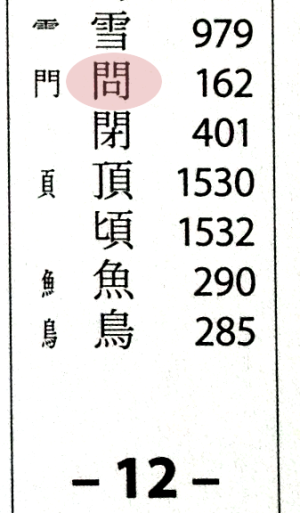
It’s 162 in the book, so I flip over to that main part of the book and see this:
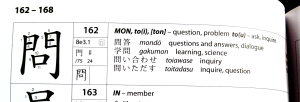
The first cell in the table shows the stroke order, so I can practice writing it correctly. The next column contains information about how the character is categorized (there’s a good explanation in the front of the book but I’ll skip it because it’s likely to frighten you as much as it frightened me). That last cell provides the pronunciations MON, to(i), and [ton] and the basic definitions, question, problem; to ask or inquire. Then four common compounds are given, using that kanji with other characters. In fact, the very phrase I’m trying to translate is there in the third example: toiawase. So although I don’t have it all figured out exactly, I can see that the phone number that follows is for inquiries about timeshares at this Disney resort. The number at the far right tells me that the other kanji in this example is number 159, a verb meaning “to put together.”
I’d Buy It.
For the true beginner, the book probably won’t be sufficient by itself. You’ll like it as a reference to supplement whatever beginner’s text you’re going through, whether you’re learning on your own or as a student in a class. If you’re a sporadic learner like me, and if you don’t already have a similar reference, I recommend this for its compactness and ease of use. One suggestion I might offer for the next edition is the unicode for each character, although I suppose most people, even those typing their kanji on a computer, don’t really need it. I’ve played around with a few similar references, but this is the first one that inspires me to keep learning, and that by itself is worth a spot on my crowded computer table. Highly recommended.








